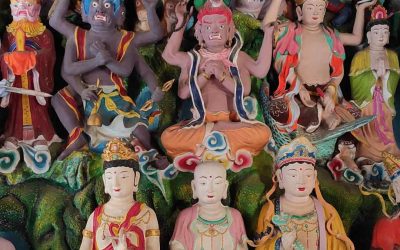Chinese Herbal Medicine Shop in Weishan, Yunnan
China still maintains a strong tradition of using natural medicines, specifically herbs with medicinal properties that have been used for centuries. In addition to being present in the composition of many modern medications, some herbalists continue their traditional trade. Even in large cities, it is not uncommon to occasionally find herbalists selling fifteen or twenty products in their small stall or shop, each stored in a plastic bag. Usually, these products do not have labels, meaning that only an expert knows exactly what each medicine is.
Herbal medicine shop
In this shop, located in the ancient city of Weishan in Yunnan province, we find what could be described as the pinnacle of Chinese herbal medicine. Within this traditional house on the main street of the old town, we discover a unique display of medicinal herbs. On the left, some medicines are neatly arranged in white plastic bags, this time identified with small labels. Higher up, in a small nod to modern civilization, others are carefully placed in plastic bottles.
A unique shop in China
However, what makes this shop stand out from all the other similar stores and stalls across China is the sheer volume of herbs stored in the white and green sacks seen on the right side of the image. It is well known that each medicinal herb must be harvested at a specific time of the year and that many of these herbs are needed in large quantities to be therapeutically effective. The foresight of this traditional pharmacist creates a truly unique scene in the ancient city of Weishan.
Wonderful Weishan Old City
Weishan is one of the oldest cities in Yunnan province. Officially designated as an autonomous district for the Yi and Muslim communities within the Bai Autonomous Prefecture of Dali, Weishan boasts significant historical, artistic, and cultural attractions. Among them, the Ancient City, with thousands of well-preserved buildings, and Weibaoshan Mountain, located 10 km from the city, stand out as the most important Taoist mountain in Yunnan.
This is why we include this city in almost all of our itineraries in Yunnan.
Last posts
The rat in the Chinese horoscope
The rat in the Chinese horoscope The rat for the Chinese is an animal to which are associated some positive and some negative qualities, in fact it is considered capable of carrying out numerous enterprises, not in vain it was the first animal to be assigned a sign of...
The Zhunti Temple in Kunming, a cult to a mysterious goddess
The Zhunti Temple in Kunming, a cult to a mysterious goddess In the center of Kunming there are barely a handful of temples left, but as one moves towards the outskirts one can still find some that for one reason or another, survived the turbulent times of religious...
Book – General introduction of the Culture of the Zhuang
Dai Guanglu and He Zhengting. The General introduction of the Culture of the Zhuang People. Yunnan Fine Arts Publishing House. Kunming, 2005. Though this book is not properly written in English, it has a two page English introduction to each of the twelve chapter it...
Two Thousand Zhuang Proverbs from China
Zhou Yanxian. Two Thousand Zhuang Proverbs from China with Annotations and Chinese and English Translation. 2017 Peter Lang Publishing, Inc., New York. 2016 If in other post I introduced a translation of the most solemn texts of the Zhuang Nationality, the myths...
Tai Cosmogonic Texts from Guangxi in Southern China
David Holm.- Recalling Lost souls: The Baeu Rodo Scriptures - Tai Cosmogonic Texts from Guangxi in Southern China. Bangkok, 2004. 344 pp. This is one of the most valuable books to know the myths and culture of the Zhuang. After an introduction to Zhuang culture and...
Mapping the Old Zhuang Character Script
David Holm. Mapping the Old Zhuang Character Script - A Vernacular Writing System from Southern China. Brill, Leiden and Boston, 2013. Excerpts from the preface The traditional Zhuang character script is an instance of a sinoxenic script, that is, a script in which...










